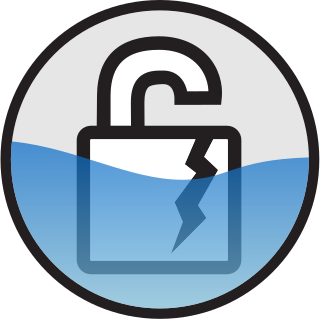Related Research Articles

The Hypertext Transfer Protocol (HTTP) is an application layer protocol in the Internet protocol suite model for distributed, collaborative, hypermedia information systems. HTTP is the foundation of data communication for the World Wide Web, where hypertext documents include hyperlinks to other resources that the user can easily access, for example by a mouse click or by tapping the screen in a web browser.

Hypertext Transfer Protocol Secure (HTTPS) is an extension of the Hypertext Transfer Protocol (HTTP). It uses encryption for secure communication over a computer network, and is widely used on the Internet. In HTTPS, the communication protocol is encrypted using Transport Layer Security (TLS) or, formerly, Secure Sockets Layer (SSL). The protocol is therefore also referred to as HTTP over TLS, or HTTP over SSL.

In computer networking, a proxy server is a server application that acts as an intermediary between a client requesting a resource and the server providing that resource. It improves privacy, security, and performance in the process.
Transport Layer Security (TLS) is a cryptographic protocol designed to provide communications security over a computer network. The protocol is widely used in applications such as email, instant messaging, and voice over IP, but its use in securing HTTPS remains the most publicly visible.

Cross-site scripting (XSS) is a type of security vulnerability that can be found in some web applications. XSS attacks enable attackers to inject client-side scripts into web pages viewed by other users. A cross-site scripting vulnerability may be used by attackers to bypass access controls such as the same-origin policy. Cross-site scripting carried out on websites accounted for roughly 84% of all security vulnerabilities documented by Symantec up until 2007. XSS effects vary in range from petty nuisance to significant security risk, depending on the sensitivity of the data handled by the vulnerable site and the nature of any security mitigation implemented by the site's owner network.

In computer networks, a reverse proxy is an application that sits in front of back-end applications and forwards client requests to those applications. Reverse proxies help increase scalability, performance, resilience and security. The resources returned to the client appear as if they originated from the web server itself.
In computer science, session hijacking, sometimes also known as cookie hijacking, is the exploitation of a valid computer session—sometimes also called a session key—to gain unauthorized access to information or services in a computer system. In particular, it is used to refer to the theft of a magic cookie used to authenticate a user to a remote server. It has particular relevance to web developers, as the HTTP cookies used to maintain a session on many websites can be easily stolen by an attacker using an intermediary computer or with access to the saved cookies on the victim's computer. After successfully stealing appropriate session cookies an adversary might use the Pass the Cookie technique to perform session hijacking. Cookie hijacking is commonly used against client authentication on the internet. Modern web browsers use cookie protection mechanisms to protect the web from being attacked.

HTTP compression is a capability that can be built into web servers and web clients to improve transfer speed and bandwidth utilization.
SPDY is an obsolete open-specification communication protocol developed for transporting web content. SPDY became the basis for HTTP/2 specification. However, HTTP/2 diverged from SPDY and eventually HTTP/2 subsumed all usecases of SPDY. After HTTP/2 was ratified as a standard, major implementers, including Google, Mozilla, and Apple, deprecated SPDY in favor of HTTP/2. Since 2021, no modern browser supports SPDY.
HTTP Strict Transport Security (HSTS) is a policy mechanism that helps to protect websites against man-in-the-middle attacks such as protocol downgrade attacks and cookie hijacking. It allows web servers to declare that web browsers should automatically interact with it using only HTTPS connections, which provide Transport Layer Security (TLS/SSL), unlike the insecure HTTP used alone. HSTS is an IETF standards track protocol and is specified in RFC 6797.

WebSocket is a computer communications protocol, providing full-duplex communication channels over a single TCP connection. The WebSocket protocol was standardized by the IETF as RFC 6455 in 2011. The current API specification allowing web applications to use this protocol is known as WebSockets. It is a living standard maintained by the WHATWG and a successor to The WebSocket API from the W3C.
Cross-site request forgery, also known as one-click attack or session riding and abbreviated as CSRF or XSRF, is a type of malicious exploit of a website or web application where unauthorized commands are submitted from a user that the web application trusts. There are many ways in which a malicious website can transmit such commands; specially-crafted image tags, hidden forms, and JavaScript fetch or XMLHttpRequests, for example, can all work without the user's interaction or even knowledge. Unlike cross-site scripting (XSS), which exploits the trust a user has for a particular site, CSRF exploits the trust that a site has in a user's browser. In a CSRF attack, an innocent end user is tricked by an attacker into submitting a web request that they did not intend. This may cause actions to be performed on the website that can include inadvertent client or server data leakage, change of session state, or manipulation of an end user's account.
HTTP/2 is a major revision of the HTTP network protocol used by the World Wide Web. It was derived from the earlier experimental SPDY protocol, originally developed by Google. HTTP/2 was developed by the HTTP Working Group of the Internet Engineering Task Force (IETF). HTTP/2 is the first new version of HTTP since HTTP/1.1, which was standardized in RFC 2068 in 1997. The Working Group presented HTTP/2 to the Internet Engineering Steering Group (IESG) for consideration as a Proposed Standard in December 2014, and IESG approved it to publish as Proposed Standard on February 17, 2015. The HTTP/2 specification was published as RFC 7540 on May 14, 2015.
Application-Layer Protocol Negotiation (ALPN) is a Transport Layer Security (TLS) extension that allows the application layer to negotiate which protocol should be performed over a secure connection in a manner that avoids additional round trips and which is independent of the application-layer protocols. It is used to establish HTTP/2 connections without additional round trips.
In computer networking, TCP Fast Open (TFO) is an extension to speed up the opening of successive Transmission Control Protocol (TCP) connections between two endpoints. It works by using a TFO cookie, which is a cryptographic cookie stored on the client and set upon the initial connection with the server. When the client later reconnects, it sends the initial SYN packet along with the TFO cookie data to authenticate itself. If successful, the server may start sending data to the client even before the reception of the final ACK packet of the three-way handshake, thus skipping a round-trip delay and lowering the latency in the start of data transmission.
BREACH is a security vulnerability against HTTPS when using HTTP compression. BREACH is built based on the CRIME security exploit. BREACH was announced at the August 2013 Black Hat conference by security researchers Angelo Prado, Neal Harris and Yoel Gluck. The idea had been discussed in community before the announcement.
POODLE is a security vulnerability which takes advantage of the fallback to SSL 3.0. If attackers successfully exploit this vulnerability, on average, they only need to make 256 SSL 3.0 requests to reveal one byte of encrypted messages. Bodo Möller, Thai Duong and Krzysztof Kotowicz from the Google Security Team discovered this vulnerability; they disclosed the vulnerability publicly on October 14, 2014. On December 8, 2014 a variation of the POODLE vulnerability that affected TLS was announced.
FREAK is a security exploit of a cryptographic weakness in the SSL/TLS protocols introduced decades earlier for compliance with U.S. cryptography export regulations. These involved limiting exportable software to use only public key pairs with RSA moduli of 512 bits or fewer, with the intention of allowing them to be broken easily by the National Security Agency (NSA), but not by other organizations with lesser computing resources. However, by the early 2010s, increases in computing power meant that they could be broken by anyone with access to relatively modest computing resources using the well-known Number Field Sieve algorithm, using as little as $100 of cloud computing services. Combined with the ability of a man-in-the-middle attack to manipulate the initial cipher suite negotiation between the endpoints in the connection and the fact that the finished hash only depended on the master secret, this meant that a man-in-the-middle attack with only a modest amount of computation could break the security of any website that allowed the use of 512-bit export-grade keys. While the exploit was only discovered in 2015, its underlying vulnerabilities had been present for many years, dating back to the 1990s.
A downgrade attack, also called a bidding-down attack or version rollback attack, is a form of cryptographic attack on a computer system or communications protocol that makes it abandon a high-quality mode of operation in favor of an older, lower-quality mode of operation that is typically provided for backward compatibility with older systems. An example of such a flaw was found in OpenSSL that allowed the attacker to negotiate the use of a lower version of TLS between the client and server. This is one of the most common types of downgrade attacks. Opportunistic encryption protocols such as STARTTLS are generally vulnerable to downgrade attacks, as they, by design, fall back to unencrypted communication. Websites which rely on redirects from unencrypted HTTP to encrypted HTTPS can also be vulnerable to downgrade attacks, as the initial redirect is not protected by encryption.

The DROWN attack is a cross-protocol security bug that attacks servers supporting modern SSLv3/TLS protocol suites by using their support for the obsolete, insecure, SSL v2 protocol to leverage an attack on connections using up-to-date protocols that would otherwise be secure. DROWN can affect all types of servers that offer services encrypted with SSLv3/TLS yet still support SSLv2, provided they share the same public key credentials between the two protocols. Additionally, if the same public key certificate is used on a different server that supports SSLv2, the TLS server is also vulnerable due to the SSLv2 server leaking key information that can be used against the TLS server.
References
- 1 2 Fisher, Dennis (September 13, 2012). "CRIME Attack Uses Compression Ratio of TLS Requests as Side Channel to Hijack Secure Sessions". ThreatPost. Retrieved September 13, 2012.
- 1 2 "CVE-2012-4929". Mitre Corporation.
- ↑ Kelsey, J. (2002). "Compression and Information Leakage of Plaintext". Fast Software Encryption. Lecture Notes in Computer Science. Vol. 2365. pp. 263–276. doi:10.1007/3-540-45661-9_21. ISBN 978-3-540-44009-3.
- ↑ "CRIME - How to beat the BEAST successor?". StackExchange.com. September 8, 2012. Retrieved September 13, 2012.
- ↑ Langley, Adam (August 16, 2011). "Re: Compression contexts and privacy considerations". spdy-dev (Mailing list).
- 1 2 Goodin, Dan (September 13, 2012). "Crack in Internet's foundation of trust allows HTTPS session hijacking". Ars Technica. Retrieved September 13, 2012.
- ↑ Rizzo, Juliano; Duong, Thai. "The CRIME attack". Ekoparty. Retrieved September 21, 2012– via Google Docs.
- ↑ Dierks, T.; Resorla, E. (August 2008). "The Transport Layer Security (TLS) Protocol Version 1.2 - Appendix A.4.1 (Hello messages)". IETF. doi:10.17487/RFC5246 . Retrieved July 10, 2013.
{{cite journal}}: Cite journal requires|journal=(help) - ↑ Leyden, John (September 14, 2012). "The perfect CRIME? New HTTPS web hijack attack explained". The Register. Retrieved September 16, 2012.
- ↑ Sysoev, Igor (September 26, 2012). "Nginx mailing list: crime tls attack". nginx.org. Retrieved July 11, 2013.
- ↑ Goodin, Dan (August 1, 2013). "Gone in 30 seconds: New attack plucks secrets from HTTPS-protected pages".